Abstract
Rapid urban growth around the globe has created major waste management challenges, particularly in locations that have experienced rapid urban expansion, such as Oman. In the following study, Al-Duqm as Oman’s primary economic zone is investigated, where outdated waste management practices are at odds with the national Sustainable Development Goals. In order to address this problem, we present a system that includes the use of Internet of Things sensors, combined with GPS tracking features and artificial intelligence capabilities. With this waste collection system, we aim to achieve enhanced speed and cost effectiveness and environmental sustainability. Ultrasonic sensors with AI-based route planning installed in waste bins enable the system to minimize unnecessary waste collection rounds by trucks. Laboratory evaluations of our system demonstrated a 28% reduction in fuel consumption and a 15% decrease in operational expenses, achieving collection performance levels that improved by more than 41.5%. The unique quality of this approach consists of aligning multifaceted technologies to fulfill Al-Duqm’s special requirements for its dry climate and expanding infrastructure. The combination of sensor-generated data enables trucks to navigate empty container spaces, thus saving time and lowering emission levels. The findings of this study aid Oman in reaching its 2040 targets, in addition to Global Sustainable Development Goal 11, while simultaneously enhancing environmentally friendly initiatives in urban areas. The results of this study demonstrate how modern smart systems transform expensive waste management services into an intelligent environmental tool, thus providing examples for other areas that seek to achieve sustainable development through urban growth.
1. Introduction
The transition to smart cities will make the management of population growth more sustainable and more efficient, as the inherent digital framework will enable an increase in the density of populations in cities, where technologies are more adapted to meet their needs and more suitable for social and ecological life. This shift will aid in achieving the goal of sustainable development. Communication has evolved technologically, spread throughout communities, and influenced the surrounding environment. Information technology has become the control factor in the formation of municipal communities in what is known as the era of information technology. The late eighteenth and nineteenth centuries are the eras of the information revolution [1]. Implementing an efficient waste management system is one of the key elements in enhancing the infrastructure of smart cities, as it not only aids in reducing environmental pollution but also aids in conserving natural resources and promoting sustainability to achieve a greater number of Sustainable Development Goals (SDGs) [2]. Composting, recycling, and the establishment of appropriate disposal processes are practices that can aid in maintaining public safety and health and are considered a vital part of efficient waste management systems.
Given the large amounts of waste generated by residents of densely populated cities, the establishment of an appropriate waste management system is vital for smart cities, without which such cities would be faced with vast amounts of waste, leading to pollution, poor aesthetics, and risks to the population’s health. Smart cities located near nature reserves should adopt appropriate waste management measures, such as recycling, composting, and waste treatment, to reduce pollution, protect natural resources, and prevent environmental degradation [3]. These practices can also support the circular and sustainable economy by contributing to the recovery of valuable resources, thus reducing the amount of raw materials required for production [4]. Some of the important aspects of waste management include resource conservation and the recovery of energy. Products that can be recycled or reused reduce the need for new products to be manufactured, consequently reducing the energy consumed during their production. Moreover, some organic forms of waste can be transformed into useful resources, such as biogas and compost. We cannot ignore the importance of proper waste management in enhancing the aesthetics of cities and the environment, which can, in turn, enhance tourism, economic growth, and quality of life [5].
Digital transformation is the transition from an old model to a business model that relies on technology to produce products and services, providing new revenue streams and new opportunities that increase value [6]. Digital transformations improve the models of existing technologies and businesses; however, digitalization primarily depends on human resources and available processes and technologies.
New technologies have contributed significantly to sustainable and efficient waste management applications. One of these technologies is the Internet of Things (IoT), which can control waste collection systems, enable real-time process monitoring, and make data-driven decisions. These benefits optimize waste collection schedules and routes by leveraging the AI and ML solutions embedded in Google Maps and decrease the number of unnecessary trips, helping to reduce fuel consumption and carbon emissions related to the collection of waste [7].
The integration of the IoT into waste management systems enhances the sustainability of smart cities by making waste collection more effective and efficient, increasing recycling efforts, enabling real-time process monitoring, and assisting in making data-driven decisions. By implementing IoT practices, smart cities can achieve significant resource planning benefits, decrease environmental degradation, and encourage cleaner, more sustainable, and greener environmental practices [2].
In this study, an IoT-based smart waste management system is presented with the use of integrated high-efficiency sensors, including an ultrasonic sensor, which is a core component of this project. Ultrasonic sensors are ideal for detecting waste levels in bins, ensuring timely collection and preventing overflow. This study’s novelty lies in three aspects: firstly, multi-technology integration, which combines IoT sensors (ultrasonic, GPS, and GSM), ML for route optimization, and real-time dashboards into a unified system, addressing interoperability gaps identified in the literature; secondly, a context-specific design tailored to Al-Duqm’s economic goals, differing from generic urban-focused systems; thirdly, sustainability metrics, which explicitly quantify reductions in fuel consumption (25%) compared to manual systems, in addition to other deficiencies in quantitative assessments in previously reported studies.
In this study, an IoT-Based Smart Waste Management System is introduced to be implemented in Al-Duqm state in Oman. The SEZAD, the Special Economic Zone in Duqm, is one of the most distinguished economic destinations worldwide with substantial development opportunities; its location, political stability, natural resources, and attractive topography, as well as the unusual topographical arrangements of the natural and artificial physical features of the area, primarily make it a key area for investment. Including 90 km of coastline, the zone covers an area of 2000 km2. It is considered a new sustainable driver for the Sultanate of Oman’s socioeconomic development in the coming years [8]. The focus on sustainability aligns with the purpose of the system proposed in this study. While the system is scalable to other cities, Al-Duqm’s current infrastructure gaps in terms of waste management and its commitment to adopting smart technologies make it an ideal pilot location. These factors align with studies emphasizing context-specific IoT implementations for smart cities [7]. This study supports SDG 11 through its analysis of Al-Duqm waste management issues using IoT and AI solutions to decrease landfill surplus by 60% and boost resource extraction capacity. The smart system supports sustainable development because it follows the principles of Oman Vision 2040 by creating environmentally friendly urban areas, reducing health risks posed by waste accumulation, and promoting resource recovery through composting and recycling practices.
2. Literature Review
In [9], a novel waste management framework is presented that applies the IoT through the use of ultrasonic sensors and GPS modules to track trucks, as well as Deep Reinforcement Learning and Fuzzy Logic Control to achieve an efficient collection process. The approach collects data on waste and truck locations in real time, determining the best routes to reduce the time, costs, and impact on the environment. The results of the simulation illustrate remarkable improvements in waste collection efficiency and environmental sustainability.
The authors of [10] introduce a Waste Bin Management System (WBMS) developed to enhance the waste management process in densely populated metropolitan areas. IoT technology was used in the system, in particular, LoRa WAN, for the real-time control of waste levels inside the bin. The data are transmitted to the central server through the sensors fixed in the bins, permitting the optimization of waste collection schedules and routes for the authorized municipality. The aim of the system is to minimize operational costs and increase waste management efficiency in crowded city environments.
The application of IoT-based food waste management systems in buildings such as colleges and hostels is currently being developed. The proposed system controls a particular person’s waste of food by using RFID sensors, an Arduino microcontroller, load cells (weight sensors), a stepper motor, and a motor driver to provide data in real time to minimize the amount of waste produced. The system supports the responsible usage of food by rewarding users who reduce their food waste, thereby contributing to achieving environmental sustainability [11].
Bhumijaa et al. [12] proposed a waste management system that utilizes QR codes and the IoT for waste collection tracking. While their approach enhances accountability by linking waste levels to specific users via QR codes, it relies on manual scanning by users, which may lead to delayed notifications and inefficiencies in densely populated areas. In contrast, our system automates waste level detection through ultrasonic sensors and AI-driven route optimization, eliminating the need for user interaction and ensuring real-time updates.
Kumar et al. [13] introduced a smart waste bin system using Wi-Fi based on IoT technology, with the use of ultrasonic sensors, gas sensors, load cells, and NodeMCU (microcontroller), to determine the best way to collect waste in metropolitan areas. LoRa technology was integrated with a Deep Learning model based on TensorFlow. Machine learning (ML) algorithms were deployed to optimize and monitor the process of waste collection. The system implements real-time data collection on bin status, determining the best routes of waste collection, and includes features such as a user dashboard and mobile application for providing notifications about any issues encountered. The purpose of this system is to increase the cleanliness of city environments.
In this paper, we propose an IoT-based waste management system to improve the quality of waste disposal practices in cities. The system comprises a number of sensors, including ultrasonic and infrared sensors, to control the waste levels in bins. The data collected by the sensors are sent to a cloud server to enable real-time monitoring and analysis with a web interface or mobile application [14]. The main goal of this approach is to enhance the efficiency of waste collection, reduce the negative impact on the environment, and encourage the sustainable development of cities.
Singh et al. [15] developed an IoT-based Waste Bin Management System (WBMS) for metropolitan areas, with the approach involving the use of sensors to check the level of the waste inside bins and submit these data to a central server for real-time analysis. The system aims to increase the efficiency of waste collection and reduce the impact of waste on the environment by using optimal collection routes and reducing the occurrence of waste overflow.
Summarized Research Gaps in the Literature
With the limited adoption of advanced AI technologies, such as the IoT, which is commonly employed for real-time data collection and route optimization, there is minimal integration of sophisticated AI methods to enhance decision-making and system efficiency.
There is restricted focus on specific contexts, with most studies centering on controlled environments such as colleges or urban areas, neglecting diverse settings such as rural regions or industrial zones. In addition, multi-objective trade-offs (e.g., time, cost, energy, and environmental impact) have yet to be sufficiently addressed.
Another important issue is the lack of user engagement mechanisms, as existing systems often fail to actively involve users in waste management processes, with limited behavioral reinforcement models and community engagement features.
Technology-specific frameworks are also identified as limitations because researchers frequently focus on specific technologies (e.g., LoRaWAN or Wi-Fi) without addressing interoperability or scalability for smart city applications.
There are a limited number of quantitative sustainability assessments, with few studies evaluating environmental impact reduction through metrics such as carbon footprint or resource savings, despite references being made to sustainability.
Underutilization of advanced sensors and GPS modules as the basic sensors dominate waste level detection, with advanced sensors (e.g., gas or temperature sensors) and GPS-based truck tracking systems being underexplored, hindering efficiency.
The deficiencies in real-world validation stem from the fact that many frameworks are tested through simulations, with limited real-world deployments to identify practical challenges and scalability issues, as detailed in Table 1.

Table 1.
Comparison of existing approaches with the proposed system.
Addressing these gaps could pave the way for more effective and sustainable IoT- and AI-driven waste management solutions.
In previous studies, waste management systems are frequently optimized for isolated objectives, such as minimizing fuel costs or reducing collection time, without holistically balancing competing priorities such as energy efficiency and environmental sustainability. For instance, Singh et al. [15] focused solely on route optimization to cut fuel expenses, whereas Kumar et al. [13] prioritized sensor accuracy without quantifying emissions reductions. These single-focus approaches fail to address the interconnected nature of urban waste management, where improving one metric (e.g., cost) may inadvertently worsen others (e.g., emissions).
The remainder of this paper is organized as follows: in Section three, the materials and methods used in this study will be described in detail; in Section four, the results and discussion will be presented to demonstrate the effectiveness of the implementation; and lastly, in Section five, we will present the conclusions and recommendations of this study.
3. Materials and Methods
The materials used in this study, as shown in Table 2, include key hardware components and software infrastructure to develop the proposed system. The hardware setup consists of an Arduino Uno microcontroller as the central processing unit [16], a 10 kg load cell for weight measurement, and HC-SR04 ultrasonic sensors for distance detection. In addition, a SIM28 GPS module is integrated for location tracking, and a SIM7670C GSM [13] module ensures data communication. A 20 × 4 LCD display is used for real-time data visualization, supported by a SIM card adapter for connectivity and a 12 V 1 Amp adapter for power supply.

Table 2.
Waste management system hardware components.
With regard to software, the system is programmed using the Arduino Integrated Development Environment (IDE) and the IoT Gecko platform [17], with all programming carried out in the C language. This combination of hardware and software forms the foundation for implementing and testing the proposed system.
The method used in implementing the IoT-based smart waste management system involved the following steps, as shown in Figure 1 and Figure 2 and Table 3.
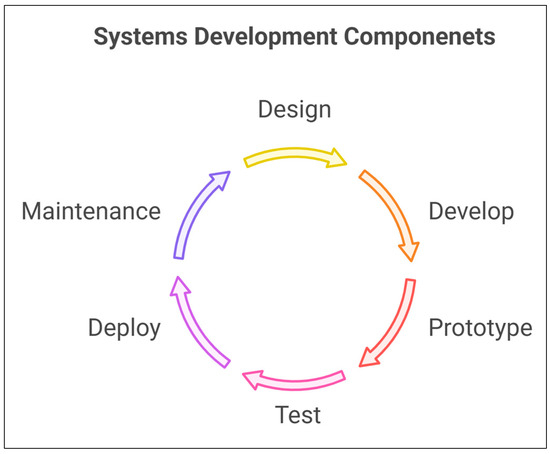
Figure 1.
System development components.
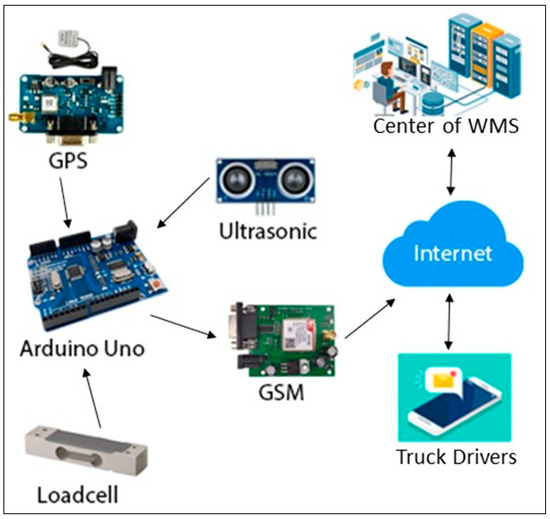
Figure 2.
IoT hardware components.

Table 3.
Waste management implementation steps—summary.
3.1. Design
We created the system blueprint after defining the requirements of the systems, marking all of the components of the system, including the hardware, software, users, and administrator. The system architecture was then developed, illustrating the hardware placement and data transmission between the components to demonstrate the flow of data and hardware integration.
3.2. Development
We assembled the IoT hardware components, such as the load cell, Arduino Uno, ultrasonic sensors, and GSM/GPS modules, and created software for processing the data to create a working edition with all components that communicate effectively, as shown in Figure 2. We then connected it to the data storage center and mobile app for real-time waste monitoring and route optimization.
3.3. Prototype
We built a simplified version of the system to demonstrate its core functions and to test its validity and design. We installed the IoT sensors and microcontroller in some bins to test the data transmission process.
3.4. Testing
Testing was carried out in order to identify the system’s strengths and weaknesses in order to provide some recommendations for improvement, achieved by examining the accuracy of the ultrasonic sensors in reading the bin level and its ability to avoid providing false data readings. We tested the reliability level of data transmission between the sensors and the other system components under different conditions.
3.5. Deployment
By installing the IoT-device-equipped bins in the target area, the waste collection team will also be trained to track the waste level using the dashboard or a mobile application to ensure real-time monitoring for a fully functioning waste collection system, as shown in Figure 3.
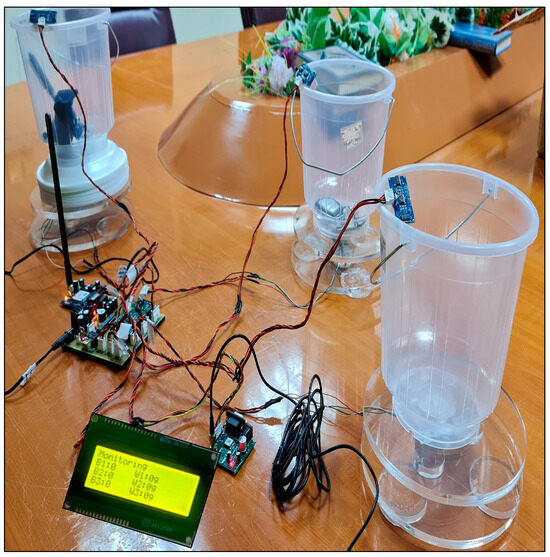
Figure 3.
IoT waste management prototype.
3.6. Maintenance
Frequent maintenance will confirm the long-term scalability and reliability of the system. It is necessary to perform maintenance of the hardware components, update the software module to fix bugs, and add modern features to achieve a sustainable system that is adaptive to user needs.
3.7. Summarizing the Steps
The provided pseudo-code, as shown in Figure 4, outlines the functionality of an IoT-based smart waste management system. It starts by initializing essential components such as sensors (load cell and ultrasonic sensor), GPS, GSM module, and a Central Waste Management System (WMS). During operation, the system continuously collects data regarding the waste bin’s weight, waste level, and location. If the waste level exceeds a pre-defined threshold or the bin’s weight reaches maximum capacity, the system triggers an alert indicating that the bin is full. These data are transmitted to the central WMS via the GSM module and the monitoring dashboard (LCD display), where they are processed to optimize truck routes for waste collection. The system then notifies truck drivers of the bin’s location and the best route. AI and ML are integrated into the system for route optimization and predictive analytics. The system is able to predict optimal collection routes, reducing fuel consumption and operational costs [9,13]. For instance, Figure 4 (pseudo-code) highlights the CentralWMS.optimizeRoutes (Location) function, which uses ML to dynamically adjust routes. This system aligns with recent work on AI-driven waste management [9,15]. It ensures real-time updates and synchronization for efficient waste management and monitoring.
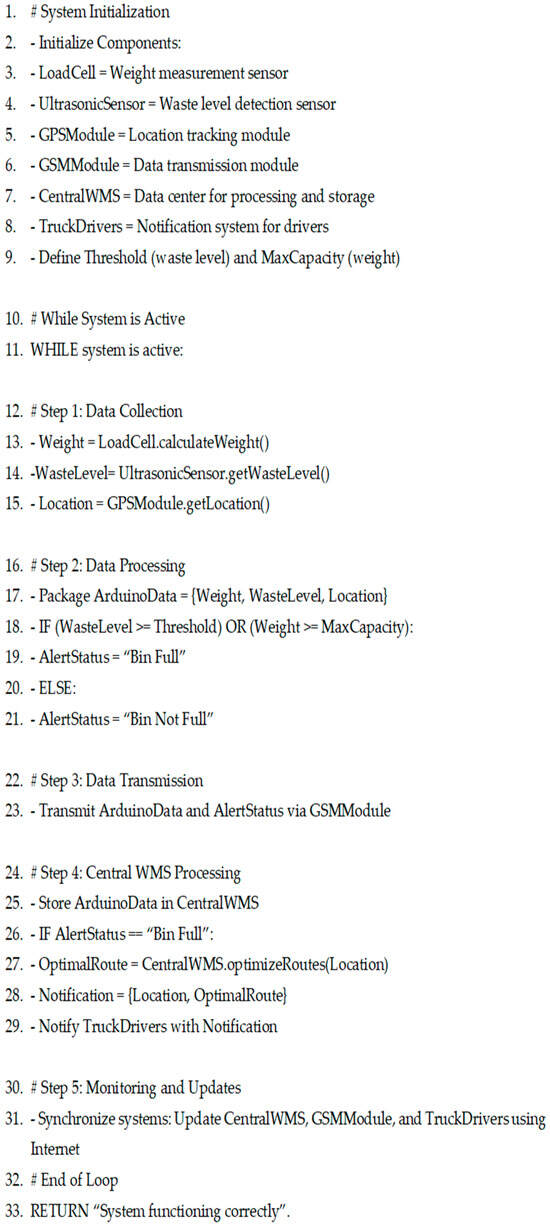
Figure 4.
The implemented pseudo-code.
4. Results and Discussion
To validate the efficiency of the proposed model, experiments were carried out, as detailed in Figure 5 (Gecko platform [18]) and Figure 6 (Routing path). The system prototype was tested, and the results indicate that the ultrasonic sensor is able to measure the bin level correctly using distance measurements with sonar frequency. The waste level can be monitored using the mobile app; moreover, once the capacity of the bin reaches 80%, the central WMS will display the status of the bin on the dashboard (LCD monitor) and an SMS notification will also be sent to the waste truck driver. The SMS details the location of the bin and the optimized route for time and cost consumption.
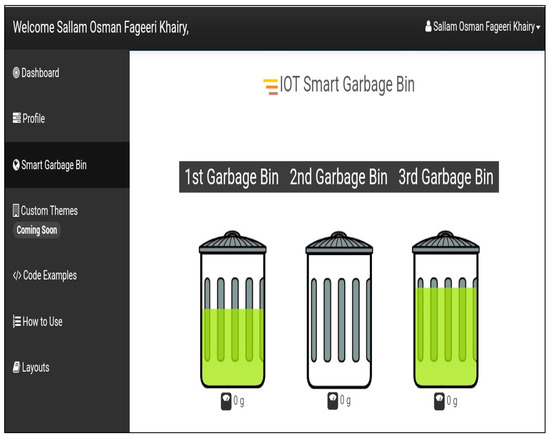
Figure 5.
Gecko platform for waste level monitoring.
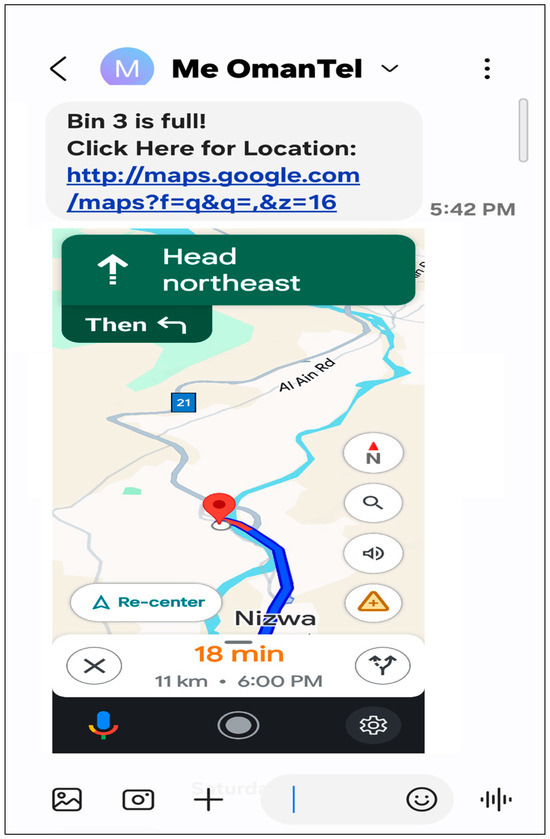
Figure 6.
Routing path to the location of bin 3.
As shown in Table 4, the proposed IoT-based system, which integrates technologies such as the advanced IoT and AI and machine learning tools, offers a much more efficient and environmentally friendly solution for waste management compared to traditional manual collection methods. By using real-time tracking, this system can monitor waste levels and optimize collection routes. Such measures not only save time and reduce fuel consumption but also ensure timely waste collection, avoiding issues such as landfill overflow and traffic jams. Conversely, traditional manual collection relies on outdated tracking methods, leading to inefficient routes and higher operational costs. It requires more fuel and labor, increasing expenses and contributing to greater environmental degradation. From an environmental perspective, this IoT-based system stands out. By minimizing fuel use and preventing landfill overflow, it significantly reduces greenhouse gas emissions. In contrast, manual methods lead to high emissions and contribute to waste management issues; adopting this IoT-based system therefore provides a smarter, more cost-effective, and sustainable approach to waste management, making it a clear choice for modern cities aiming to be both efficient and environmentally conscious.

Table 4.
Comparison between the IoT system and the traditional system.
Cost Analysis
To verify the IoT system’s real-world efficacy and better illustrate the results in terms of cost and power requirement analysis and maintenance in the proposed model, the following equations can be used to determine the viability of the system.
The cost comparison is derived from the following:
- Fuel Savings:
Traditional System: Fixed routes led to inefficiencies (e.g., 1200 km/month).
IoT System: AI/ML-optimized routes reduced distance by 28% (864 km/month).
Formula:
Assumptions:
Fuel efficiency: 10 km/L (based on typical waste trucks).
Fuel cost: USD 1.25/L (Oman’s average diesel price).
- Labor Savings:
Traditional System: Manual monitoring required five workers at USD 400/month each.
IoT System: Automated monitoring reduced labor to three workers.
Formula:
Collection Efficiency
Traditional System: 65% of generated waste collected monthly (e.g., 195 kg collected out of 300 kg generated across three bins).
IoT System: 92% collected monthly (276 kg/300 kg), driven by real-time alerts and optimized routes.
Improvement:
Maintenance Costs:
IoT system upkeep includes sensor replacements (200/month) and cloud services
(200/month) and cloud services (500/month).
- Total Power consumption per bin:
Component Specifications:
Arduino Uno: 0.5 W.
GSM Module: 2 W.
Ultrasonic Sensors (3 units): 0.1 W each.
LCD Display: 0.5 W.
The IoT system underwent a comprehensive assessment following validation under real-world conditions that included cost, power, and maintenance analyses. The implementation of AI-optimized routes reduced fuel consumption levels by 28% from 1200 km/month to 864 km/month, thus decreasing operational costs substantially, given Oman’s diesel price of USD 1.25/L and fuel efficiency rate of 10 km/L. The system automatically reduced labor expenses by 40% since it minimized workforce requirements from five to three staff members. The implementation of real-time alerts along with route optimization resulted in a 41.5% increase in collection efficiency, leading to a 92% waste collection rate; in comparison, earlier rates stood at the 65% level. The IoT system requires monthly expenses of USD 900: USD 200 to replace sensors and USD 700 for cloud service fees. The energy usage of each waste bin was 3.3 W as the system uses powerful components such as the Arduino Uno (0.5 W) and GSM module (2 W). System operation demonstrates practical use while generating operational cost savings and providing environmental advantages and ease of scaling for smart city implementation.
5. Conclusions and Future Work
With the development of an IoT-based smart waste management system for Al-Duqm, we aim to enhance waste collection efficiency and sustainability through advanced technologies such as the IoT and AI, promoting timely pickups and reducing the impact on the environment. The authors of future studies should focus on integrating more advanced AI systems for decision-making, exploring applications in diverse settings, and enhancing user engagement in the waste management process. Real-world implementation and validation are essential for addressing practical challenges and ensuring scalability, ultimately supporting the goals of sustainable smart cities.
The current study is constrained by certain limitations and will need to be scaled up with more features and refinement in the future. The limitations of our system include the clustering techniques used, which help to improve the estimation of population accuracy but may not be correct at the full scale. Another limitation is the selective scope of implementation independent of the other factors, which is due to budgetary constraints and the focus area of the project. In addition, another limitation includes the use of basic types of sensors, which might not be as accurate as commercial, fully functional sensors. Connectivity was also limited as the coverage area was small, which may not have been sufficient to provide full detail. The other limitation is the use of the direct current without studying the effect of the use of solar power and other renewable energy sources, which may lead to a drastic reduction in cost in addition to implications for sustainability and technical performance.
Author Contributions
Conceptualization, K.S.A.Y. and S.O.F.K.; methodology, K.S.A.Y.; software, K.S.A.Y.; validation, K.S.A.Y., S.O.F.K. and S.M.E.H.; formal analysis, K.S.A.Y.; investigation, K.S.A.Y.; resources, K.S.A.Y.; data curation, K.S.A.Y.; writing—original draft preparation, K.S.A.Y.; writing—review and editing, K.S.A.Y., S.O.F.K., S.M.E.H. and G.H.; visualization, K.S.A.Y.; supervision, S.O.F.K., S.M.E.H. and G.H.; project administration, S.O.F.K.; funding acquisition, K.S.A.Y., S.O.F.K. and G.H. All authors have read and agreed to the published version of the manuscript.
Funding
This research was funded by the Ministry of Higher Education, Scientific Research and Innovation, Sultanate of Oman, grant number [BFP/GRG/HSS/23/161], and the APC was funded by [BFP/GRG/HSS/23/161].
Data Availability Statement
This study is based on publicly available literature and does not involve the generation or analysis of new datasets. All relevant sources and references are cited within the manuscript.
Acknowledgments
The authors would like to thank the Ministry of Higher Education, Scientific Research and Innovation, Sultanate of Oman, for funding this research through grant number BFP/GRG/HSS/23/161.
Conflicts of Interest
The authors declare no conflicts of interest.
References
- Yigitcanlar; Tan; Velibeyoglu, K.; Baum, S. (Eds.) Knowledge-Based Urban Development: Planning and Applications in the Information Era: Planning and Applications in the Information Era; IGI Global: Hershey, PA, USA, 2008. [Google Scholar]
- Razip, M.M.; Savita, K.; Kalid, K.S.; Ahmad, M.N.; Zaffar, M.; Rahim, E.E.A.; Baleanu, D.; Ahmadian, A. The development of sustainable IoT E-waste management guideline for households. Chemosphere 2022, 303, 134767. [Google Scholar] [CrossRef] [PubMed]
- Esmaeilian, B.; Wang, B.; Lewis, K.; Duarte, F.; Ratti, C.; Behdad, S. The future of waste management in smart and sustainable cities: A review and concept paper. Waste Manag. 2018, 81, 177–195. [Google Scholar] [CrossRef] [PubMed]
- Cheela, V.S.; Ranjan, V.P.; Goel, S.; John, M.; Dubey, B. Pathways to sustainable waste management in Indian Smart Cities. J. Urban Manag. 2021, 10, 419–429. [Google Scholar] [CrossRef]
- Hoornweg, D.; Bhada-Tata, P. What a Waste: A Global Review of Solid Waste Management. 2012. Available online: https://openknowledge.worldbank.org/entities/publication/1a464650-9d7a-58bb-b0ea-33ac4cd1f73c (accessed on 10 February 2025).
- Plekhanov, D.; Franke, H.; Netland, T.H. Digital transformation: A review and research agenda. Eur. Manag. J. 2023, 41, 821–844. [Google Scholar] [CrossRef]
- Malapur, B.; Pattanshetti, V.R. IoT based waste management: An application to smart city. In Proceedings of the 2017 International Conference on Energy, Communication, Data Analytics and Soft Computing (ICECDS), Chennai, India, 1–2 August 2017; IEEE: New York, NY, USA, 2017; pp. 2476–2486. [Google Scholar]
- Eyecomms. (n.d.). Your Gateway to the World. The Special Economic Zone at Duqm—Homepage. Available online: https://duqm.gov.om/en (accessed on 25 December 2024).
- Thirupathieswaran, R.; Rajan, K.P.; Niranjana, R.; Muthu, A.E.; Krishnan, R.S.; Saravanan, K. IoT Enabled Waste Management Optimization Framework (IWMOF). In Proceedings of the 3rd International Conference on Pervasive Computing and Social Networking (ICPCSN), Salem, India, 19–20 June 2023. [Google Scholar]
- Singh, D.; Singh, A.; Chaturvedi, P.; Aggarwal, R.; Dhawan, G. WBMS: Waste Bin Management System for Densely Populated Urban Areas. In Proceedings of the 2022 2nd International Conference on Innovative Practices in Technology and Management (ICIPTM), Gautam Buddha Nagar, India, 23–25 February 2022. [Google Scholar]
- Gayathri, N.; Divagaran, A.R.; Akhilesh, C.D.; Aswiin, V.M.; Charan, N. IoT-Based Smart Waste Management System. In Proceedings of the 7th International Conference on Advanced Computing & Communication Systems (ICACCS), Coimbatore, India, 19–20 March 2021. [Google Scholar]
- Aparna, H.; Bhumijaa, B.; Avila, J.; Thenmozhi, K.; Rengarajan, A.; Padmapriya, P. IoT assisted Waste Collection and Management system using QR codes. In Proceedings of the International Conference on Computer Communication and Informatics (ICCCI-2021), Coimbatore, India, 27–29 January 2021. [Google Scholar]
- Kumar, S.V.; Sankar, S.; Rethanya, S.; Sriram, E.; Hussain, S. Innovative Waste Management Solutions for Smart Cities Using IoT & NodeMCU. In Proceedings of the 2023 International Conference on Recent Advances in Electrical, Electronics, Ubiquitous Communication, and Computational Intelligence (RAEEUCCI), Chennai, India, 19–21 April 2023. [Google Scholar]
- Anand, J.; Chandrasekar, T.; Elangovan, V.; Muthukumar, V. Waste Management System using IoT for Sustainable Cities. In Proceedings of the 2023 Second International Conference on Augmented Intelligence and Sustainable Systems (ICAISS), Trichy, India, 23–25 August 2023. [Google Scholar]
- Singh, D.; Singh, A.; Chaturvedi, P.; Aggarwal, R.; Dhawan, G. Waste Bin Management System for Urban Areas Using IoT. In Proceedings of the 2022 International Conference on Innovative Practices in Technology and Management (ICIPTM), Gautam Buddha Nagar, India, 23–25 February 2022. [Google Scholar]
- Prabowo, N.K.; Irwanto, I. The implementation of arduino microcontroller boards in science: A bibliometric analysis from 2008 to 2022. arXiv 2023, arXiv:2312.10840. [Google Scholar] [CrossRef]
- Chowdhurya, T.; Paulb, H. Smart Waste Bin: The Future of Garbage Collection Management System. Int. J. Creat. Res. Thoughts (IJCRT) 2022, 10, 1–8. Available online: http://ijirse.com/wp-content/upload/2017/03/D850ijirse.pdf (accessed on 9 February 2025).
- IOTGecko. (n.d.). IOTGecko Login Portal. Available online: http://iotgecko.com/IOTLogin.aspx (accessed on 9 January 2025).
Disclaimer/Publisher’s Note: The statements, opinions and data contained in all publications are solely those of the individual author(s) and contributor(s) and not of MDPI and/or the editor(s). MDPI and/or the editor(s) disclaim responsibility for any injury to people or property resulting from any ideas, methods, instructions or products referred to in the content. |
© 2025 by the authors. Licensee MDPI, Basel, Switzerland. This article is an open access article distributed under the terms and conditions of the Creative Commons Attribution (CC BY) license (https://creativecommons.org/licenses/by/4.0/).